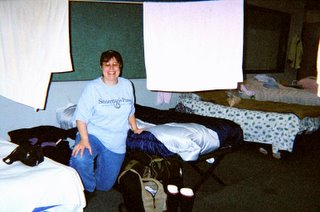
Our camp was in a community center in Gretna, La (across the river from New Orleans).
Samaritans purse staff had divided the building into mens and womens sleeping quarters, an eating area and office area. Rest rooms were outside but nearby. Also nearby was the shower trailer, the tool pick up area and the trailers housing the staff.


I can't say enough about how excellant the staff was. They kept the camp running without a hitch, everything spotless and organized. They always answered our questions with a smile, although they must be asked the same questions every week, since that is how often the teams are changed out. Lights came on at 6:00 a.m. and went off at 9:30 p.m. Each team had a job to do in the morning and ours was making about 65 sandwiches for lunch. Our chef, who kept us very well fed, was quite a particular fellow. It was either 5 slices of salami, or 2 slices of ham or 3 slices of turkey per sandwich, NO MORE, NO LESS! Speaking of food, it was quite different then home. Favorites are spicy gumbo, red beans and rise with sausage and corn bread, BBQ ribs, chicken, shrimp, crawfish and sweet potato pie. The weather was cool in the evenings but definately spring time during the day. The camilias, pecan trees, palm tress and magnolias were leafing out or in bloom (as least the ones that were not killed by the flood or knocked over by the hurricane.)




















